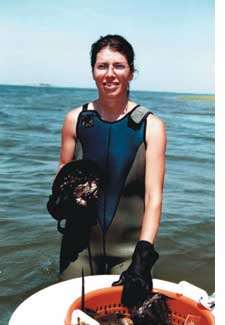 |
 |
|
 |
 |
 |
 |
 |
|
 |
 |
 |
 |

|
| |
 
Summer 2003, Vol. 12, No. 5 | Return to Table of Contents
BUMP Completes Study of Pleasant Bay Horseshoe Crab Population Dynamics
 Boston University Marine Program students Ruth Carmichael (Ph.D. candidate) and Deborah Rutecki (MA ‘02), under the direction of Ivan Valiela, have completed a study to discern the status of horseshoe crab population dynamics in terms of abundance, survival, recruitment, and distribution in Pleasant Bay, the largest estuary on Cape Cod. The study is the first to construct a comprehensive description of population structure of horseshoe crabs across an entire estuary. The results of the work appeared in Marine Ecology Progress Series (246: 225-239) and in a report, “Population dynamics and ecology of the Atlantic horseshoe crab (Limulus polyphemus) in Pleasant Bay, MA,” available at the MBL/WHOI Library. Boston University Marine Program students Ruth Carmichael (Ph.D. candidate) and Deborah Rutecki (MA ‘02), under the direction of Ivan Valiela, have completed a study to discern the status of horseshoe crab population dynamics in terms of abundance, survival, recruitment, and distribution in Pleasant Bay, the largest estuary on Cape Cod. The study is the first to construct a comprehensive description of population structure of horseshoe crabs across an entire estuary. The results of the work appeared in Marine Ecology Progress Series (246: 225-239) and in a report, “Population dynamics and ecology of the Atlantic horseshoe crab (Limulus polyphemus) in Pleasant Bay, MA,” available at the MBL/WHOI Library.
The researchers estimated that there were 13.5 million juvenile and 500,000 adult horseshoe crabs in Pleasant Bay during the 2001 spawning season. These estimates include crabs buried shallowly in the sediments and non-spawning adults, which which are often missed in traditional spawning and trawl surveys. Results of the study showed that although females deposit large numbers of eggs, only about one egg per thousand hatches and survives to the end of the first year of life; approximately 78% of these yearling juveniles reach adulthood. These mortality rates are similar to those found among populations of crustacea, including some true crabs and lobsters.
In a related study, Rutecki estimated the magnitude and characteristics of crabs harvested from the Bay for bait, and for biomedical and scientific research. Horseshoe crabs harvested from Pleasant Bay for all purposes accounted for mortality of approximately 1-2% of the adult population, a rate that is lower than estimates for other Cape Cod areas. The results of this study are in review for publication.
Research was also conducted to determine where horseshoe crabs feed in Pleasant Bay and what they are eating. Carmichael and others found that adults foraged throughout the Bay, but avoided sites of high nutrient enrichment. This finding raises the question of how water quality may affect horseshoe crab distribution.
|
 |
|
|
 |
 |
|